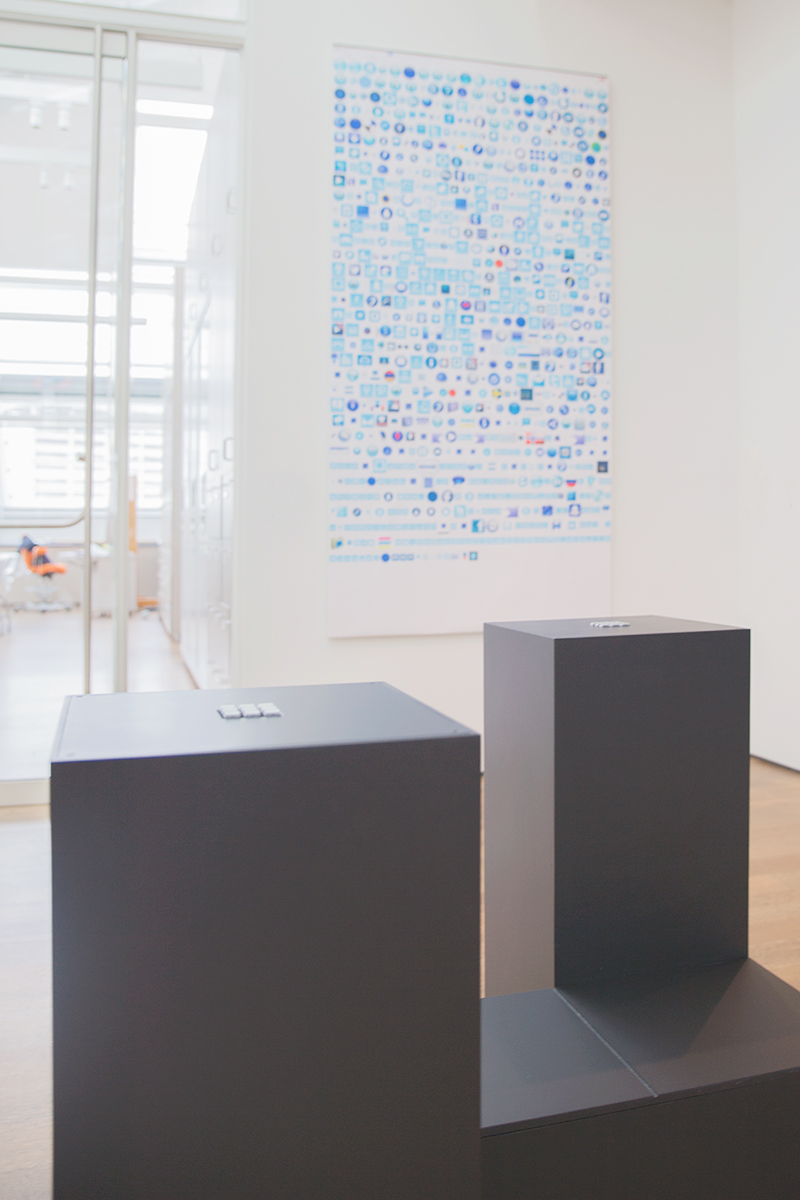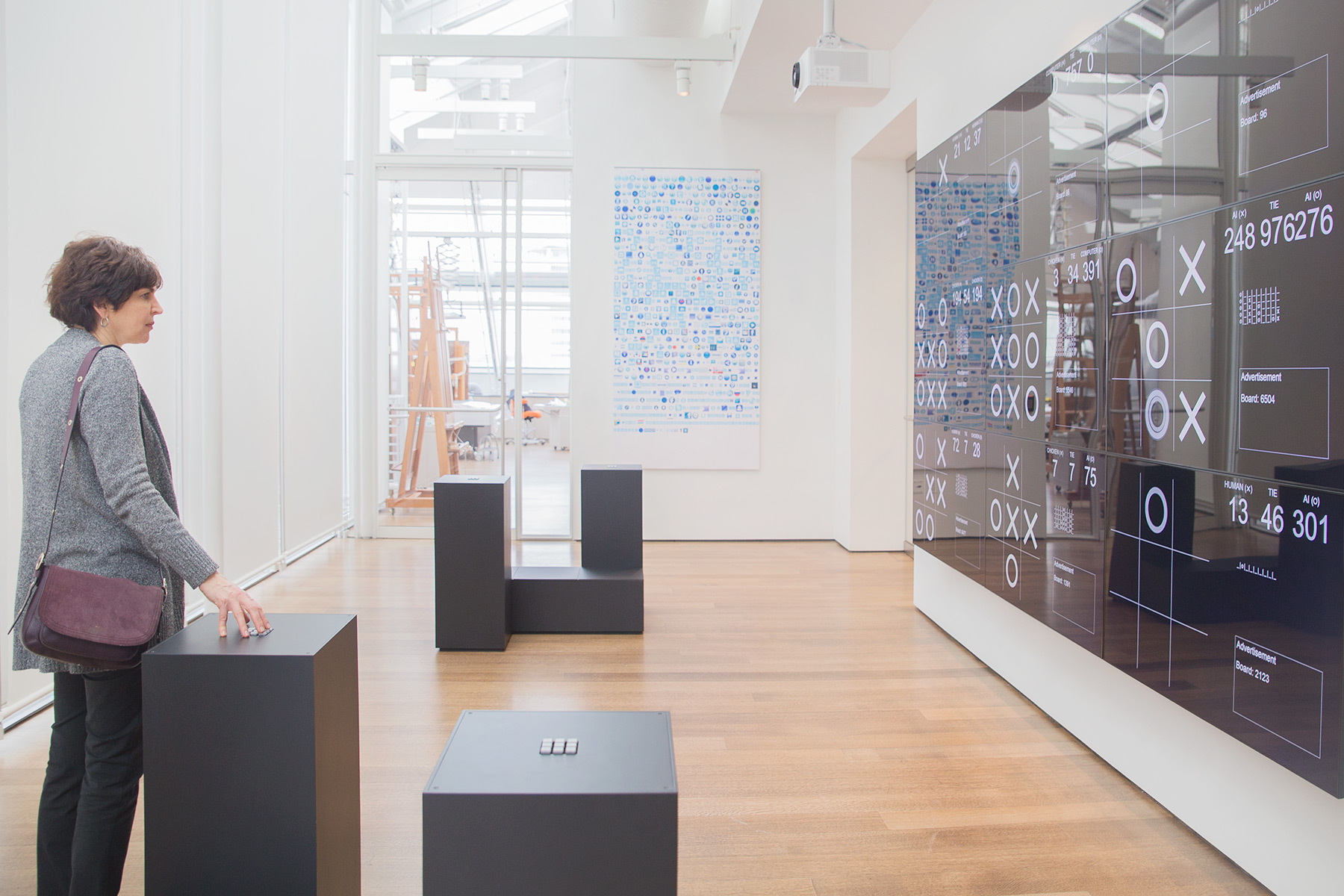For the next two months, our Lightbox Gallery is featuring JODI: OXO, a new installation by JODI, the technology-focused artist collective formed in 1994 by Joan Heemskerk and Dirk Paesmans. The work is a contemporary take on tic-tac-toe, or OXO.
Games in the Gallery

But it’s more than an interactive game; it’s a meditation on an enduring cultural artifact and a window into the power of artificial intelligence.
“This game is so simple you might have played it in kindergarten or even earlier,” said Heemskerk, who spoke to a Harvard Graduate School of Design class on February 7, the day the installation opened. (It remains on view through April 23, 2018.) Yet when a computer is pre-programmed to play tic-tac-toe, as in this installation, the game can become nearly impossible to win. Its very simplicity underscores the strength of today’s technology.
JODI: OXO is inspired by early computing and war games, but primarily by Noughts and Crosses or OXO, a game built in 1952 by Alexander S. Douglas. Though versions of tic-tac-toe had existed for centuries, Heemskerk said that Douglas’s game was the first to allow humans to play against a computer. (She added that the initial “opponent” was probably the size of the Lightbox Gallery itself.)
The installation is presented in collaboration with the Institute of Contemporary Art/Boston (ICA) exhibition Art in the Age of the Internet, 1989 to Today (February 7–May 20, 2018), which explores the effects of the Internet on artistic practice and contemporary culture. The Harvard Art Museums are among the 14 Boston-area arts and cultural organizations that are hosting events, exhibitions, or panels associated with the ICA exhibition.
JODI: OXO is organized by Mary Schneider Enriquez, the Houghton Associate Curator of Modern and Contemporary Art, and Chris Molinski, associate research curator for digital initiatives. Technology support specialist Ian Callahan and technology fellow Whitney Christopher assisted with the digital development of the project.
“It’s been a wonderfully exciting challenge to see how we can respond nimbly to the ICA exhibition, and support the development of JODI’s installation,” Schneider Enriquez said.
The Lightbox Gallery, which has hosted dozens of installations by a range of artists and geared toward a variety of audiences, presented JODI with both ample creative opportunity and some physical parameters they’d need to work within while planning the project. The duo had a tic-tac-toe-related installation in mind even before viewing the space, but Heemskerk said the gallery’s nine digital panels, as well as the surrounding windows and glass roof, played a large part in shaping the work’s ultimate form. As with any site-specific installation, Heemskerk said, “we had to commit to the facilities already here.”
JODI: OXO features nine different games, one in each panel. Five are played entirely by virtual players—including “chickens,” “computers,” and “AI” (artificial intelligence). The four games on corner panels offer the chance for visitors to play. In one instance, two humans play against each other; the other three games pit a visitor against the virtual players. Four pedestals, each with a panel of nine buttons corresponding to a standard tic-tac-toe grid, invite visitors to select where to place their Xs and Os.
Some visitors may wonder why a “chicken” is involved in the installation. The answer lies in the history of tic-tac-toe, Heemskerk said. In the not-so-distant past, people sometimes “played” against live chickens in an early arcade game sometimes called Bird Brain. The chicken, locked in a small booth, would press a button connected to a simple computer program that decided the corresponding tic-tac-toe moves. Thus, the installation references a longer history of artificial intelligence, in addition to early computer games.
In such an innovative, experimental space as the Lightbox Gallery, the installation provides a point of connection for audiences of many backgrounds. It also offers a new perspective on the role of art in a traditional museum setting. As Molinski said, “It’s challenging the idea of play and games within a collection.”


